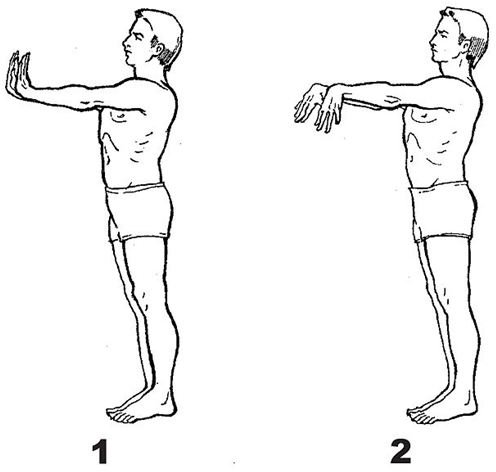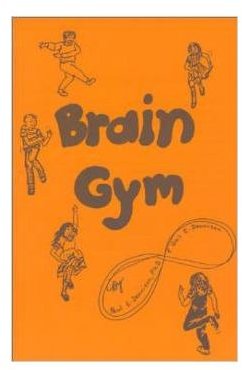Brain Gym Technique: Cognition, Focus and Coordination
Repatterning
The theory behind Brain Gym curriculum, developed by Dr. Paul Dennison, is that when repeated movements stimulate the brain, it
functions at a higher level and/or balances. The 26 movements taught at Brain Gym seminars are all based on movements humans make as infants and children. By repeating these movements, people with learning difficulties have been said to find learning comes easier.
The simplest description of this technique is that through the 26 movements or activities, the brain creates new neural pathways, which allow the brain to perform tasks that were once difficult. To the right you’ll see an image of Dr. Dennison’s book.
Nothing New
The science behind this theory is not new. It is the same theory that doctors and therapists use when re-educating stroke victims. The repeated use of limbs, moving the body in repeated patterns, stimulates the healthy part of the brain to take over the work of the portion of the brain damaged by stroke.
In research done by scientist/doctors at Johns Hopkins University, patients recovering from strokes retrained their brains by walking on a treadmill. Patients taking part in the research “…participated in an exercise program that principally involved walking on a treadmill three times a week for up to 40 minutes, assisted by a supporting sling and tether if needed. Physical therapists assigned to each subject increased the intensity of the workouts over time by increasing the treadmills’ speed and incline, though the workouts never taxed the patients beyond a moderate level of 60 percent VO2 peak.”
After six months, these patients showed vast improvement over the other patients in the group that only participated in stretching exercises. “This suggests that the brain is responsible for the improvement we saw in patients’ walking ability. It seems to be recruiting other regions to take on the job of areas damaged by stroke,” says Andreas Luft, M.D., one of the visiting researchers in the study.
From Rehab to Classroom
Dr. Dennison’s theory that children with learning difficulties could use movements to stimulate the brain, thereby retraining the brain to function at higher levels is an advance for which many parents and academics dreamed.
Working on the same principles as the Johns Hopkins study, Brain Gym uses exercises that take the student back to the fundamental movements of childhood. Interestingly, these movements can be done by anyone with the same results.
Classroom Effectiveness
The big question here is: should teachers use Brain Gym activities/curriculum in their classrooms to enhance the learning abilities of their students?
Many teachers have taken the Brain Gym training. It is costly. Total training is not given in one course or seminar. Teachers will need to take several courses to learn all the techniques and activities Brain Gym International has to offer.
Those educators who have incorporated the techniques and activities into their classrooms report good results. Simple movements such as putting pressure on points about the eyes (called Positive Pressure) or waving the hands in the air in mirror image (called the Double Doodle) are said to shift stress and improve thinking.
Proof Is in the Research
Brain Gym International is a non-profit organization. As such, it has limited funds for research. However, on its website, Brain Gym International encourages researchers to assess the Brain Gym technique and curriculum.
Research on the connection between kinesiology and the brain (movement and the brain) has a long history. In fact, Dr. Dennison was one of the first educators to work with movement and brain activity. Educators who wish to find proof for how and why simple movements allow the brain to function more efficiently can find hundreds of articles on the subject in journals such as “Neurology Today” and “The International Journal of Applied Kinesiology.” Websites for educators such as Move to Learn offer articles and information.
Additionally, there is any number of educational conferences with presentations and seminars being offered on the topic of using movement in the classroom to focus and guide students to higher levels of learning.
In the Classroom
While the 26 movements/activities of Brain Gym can be found on the web, educators need to be cautioned that Brain Gym International has a copyright on their curriculum. Therefore, using them without instruction and permission from Brain Gym International would be inadvisable.

However, educators without the funds to attend Brain Gym training might try utilizing simple yoga exercises. There are research articles, as well as websites on yoga in the classroom. Some sites give free instruction, such as Yogakids.com.
Whether incorporating Brain Gym technique, yoga or other movement into the curriculum, educators will find students respond positively to simple, mindful movements.
References
- Brain Gym International
- Move to Learn: Overcoming Learning Difficulties
- Johns Hopkins Medicine: Treadmill Exercise Retrains the Brain and Body of Stroke Victims, 2008
- Yoga Pose: by Belik Maria Aleksandrovna under CC by -SA 3.0
- Yoga Kids: Tools for Schools
